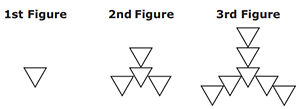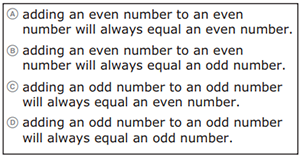General Information
Clusters should not be sorted from Major to Supporting and then taught in that order. To do so would strip the coherence of the mathematical ideas and miss the opportunity to enhance the major work of the grade with the supporting clusters.
Test Item Specifications
Items may only contain whole numbers from 0 to 1,000. Operations in rules are limited to addition, subtraction, multiplication, and division. Items may not contain a rule that exceeds two procedural operations. Division rules may not require fractional responses. Rules may not be provided algebraically (e.g., x + 5). Items must provide the rule.
No
Allowable
Sample Test Items (2)
| Test Item # | Question | Difficulty | Type |
| Sample Item 1 | The first number in a pattern is 5. The pattern follows the rule "Add 3." What is the next number in the pattern? |
N/A | EE: Equation Editor |
| Sample Item 2 | A pattern starts with one triangle and follows the rule: "Add one triangle to the top, add one triangle to the left, add one triangle to the right." The first three figures for the pattern are shown.
Complete the statement to describe the 4th figure for the pattern shown. For each blank, fill in the circle before the word or phrase that is correct. The 4th figure for the pattern will have an
number of triangles because
|
N/A | ETC: Editing Task Choice |
Related Courses
| Course Number1111 | Course Title222 |
| 5012060: | Grade Four Mathematics (Specifically in versions: 2014 - 2015, 2015 - 2022, 2022 - 2024, 2024 and beyond (current)) |
| 7712050: | Access Mathematics Grade 4 (Specifically in versions: 2014 - 2015, 2015 - 2018, 2018 - 2022, 2022 and beyond (current)) |
| 5012065: | Grade 4 Accelerated Mathematics (Specifically in versions: 2019 - 2022, 2022 - 2024, 2024 and beyond (current)) |
| 5012015: | Foundational Skills in Mathematics 3-5 (Specifically in versions: 2019 - 2022, 2022 - 2024, 2024 and beyond (current)) |
Related Resources
Educational Game
| Name | Description |
| Guess My Rule | Function Machine card game is used to reinforce student understanding of functions using an in/out table. |
Formative Assessments
| Name | Description |
| Multiply By Four | Students are asked to generate a sequence of numbers based on a given rule and then to identify features of the pattern that are not explicit. |
| Dot Patterns | Students examine triangular numbers through a given dot pattern. |
| Shape Patterns | Students are asked to analyze a shape pattern, continue the pattern, and identify what a future shape will be if the pattern continues. |
| Baseball Cards | Students generate a number pattern based on a given rule and explain the pattern found. |
Lesson Plans
| Name | Description |
| Pattern Fun | In this lesson, students will use manipulatives to build, extend, and describe increasing patterns from a rule. |
| Rules, Number Patterns, and Tables | In this introductory lesson students will follow a rule to generate a number pattern in a table and then identify apparent features of the pattern. |
| Fish Ahoy Fish | Students will work in groups to assist a client in purchasing different fish for a fish pond. From a data table, they will need to decide which type of fish and how many fish to purchase according to the size of the each pond. After, they will need to revisit a revised data table to make different selection of fish and calculate costs for the purchase of the fish. Model Eliciting Activities, MEAs, are open-ended, interdisciplinary problem-solving activities that are meant to reveal students’ thinking about the concepts embedded in realistic situations. MEAs resemble engineering problems and encourage students to create solutions in the form of mathematical and scientific models. Students work in teams to apply their knowledge of science and mathematics to solve an open-ended problem, while considering constraints and tradeoffs. Students integrate their ELA skills into MEAs as they are asked to clearly document their thought process. MEAs follow a problem-based, student centered approach to learning, where students are encouraged to grapple with the problem while the teacher acts as a facilitator. To learn more about MEA’s visit: https://www.cpalms.org/cpalms/mea.aspx |
| The n-gon Train | In this lesson, students will determine the perimeter of a train of polygons, for different regular polygons. The accompanying videos (intended audience is teachers) provide segments of an implementation of the lesson. |
Original Student Tutorial
| Name | Description |
| Wubble Double Trouble | Join Pete as he explores patterns within patterns with feisty Wubbles and Dipples in this interactive tutorial. |
Perspectives Video: Teaching Idea
| Name | Description |
| Classroom Storytime: Creating Mathematical Models | Watch as the Wubbles double to show you how a mathematical pattern can be made. Download the CPALMS Perspectives video student note taking guide. |
Problem-Solving Task
| Name | Description |
| Double Plus One | The purpose of this task is to help students gain a better understanding of patterns. This task is meant to be used in an instructional setting. |
Teaching Ideas
| Name | Description |
| Recognizing Patterns | This lesson is designed to introduce and familiarize students with patterns of shapes, sequences, and tessellations. This lesson provides links to discussions and activities related to patterns and sequences as well as suggested ways to integrate them into the lesson. Finally, the lesson provides links to follow-up lessons designed for use in succession with the current one. |
| Engineers Speak For The Trees | Students begin by reading Dr. Seuss' "The Lorax" as an example of how overdevelopment can cause long-lasting environmental destruction. Students discuss how to balance the needs of the environment with the needs of human industry. |
Tutorial
| Name | Description |
| Number Pattern Example: Growing Sequence | In this Khan Academy tutorial video a table is used to track a growing sequence of design. |
Virtual Manipulative
| Name | Description |
| Follow the Pattern. Which shapes go next? | Students select the shape that goes next in the pattern and place it in the row, then identify the overall pattern. |
Student Resources
Original Student Tutorial
| Name | Description |
| Wubble Double Trouble: | Join Pete as he explores patterns within patterns with feisty Wubbles and Dipples in this interactive tutorial. |
Problem-Solving Task
| Name | Description |
| Double Plus One: | The purpose of this task is to help students gain a better understanding of patterns. This task is meant to be used in an instructional setting. |
Tutorial
| Name | Description |
| Number Pattern Example: Growing Sequence: | In this Khan Academy tutorial video a table is used to track a growing sequence of design. |
Virtual Manipulative
| Name | Description |
| Follow the Pattern. Which shapes go next?: | Students select the shape that goes next in the pattern and place it in the row, then identify the overall pattern. |
Parent Resources
Problem-Solving Task
| Name | Description |
| Double Plus One: | The purpose of this task is to help students gain a better understanding of patterns. This task is meant to be used in an instructional setting. |



